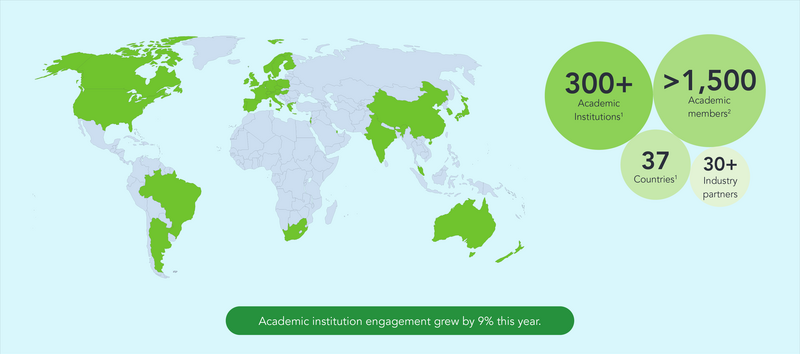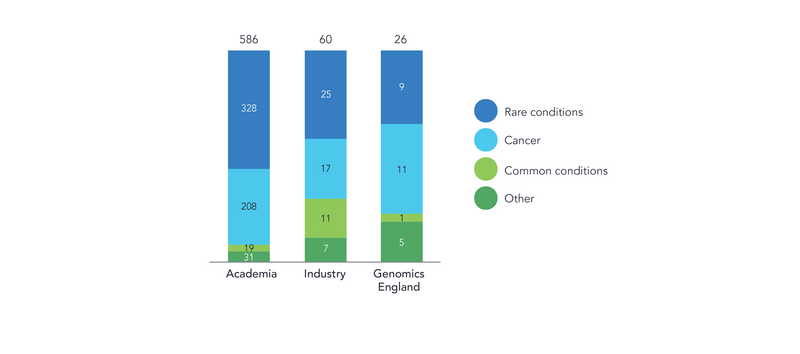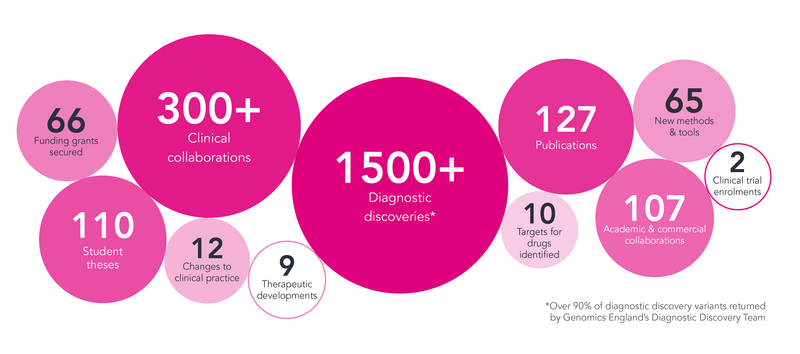A year of discovery: 2025 Research Network in review
By Xan Sieghart onWhat is the Research Network?
The Genomics England Research Network is made up of over 1500 researchers from across the globe, working on the genomic and clinical data in the National Genomic Research Library (NGRL), a secure database managed by Genomics England in partnership with the NHS. These researchers include academics, healthcare professionals and industry partners, who work collaboratively to make scientific discoveries about cancer and rare conditions.

Tracking research progress
In order to access the Research Environment, research groups must submit project proposals describing how they intend to use the NGRL data. These are reviewed by Genomics England to ensure they align with our ethical frameworks, and are also made publicly available in our Research Registry to provide transparency on precisely how participants’ data is being used.
Each year project leads are asked to provide a status update on the progress of their work. In 2025, over 700 projects were surveyed and 95% of researchers responded, supplying details on the broad range of research outputs being generated thanks to data from the NGRL.
Active projects, active progress
The vast majority of projects remain in progress (77%), meaning that work is still ongoing and analysis is underway. A further 8% of projects were completed this year, having achieved their research goals. While 1% of projects are approved but not yet started, and the remaining 14% have become inactive. These projects reported that changing research priorities and funding landscapes led to delays or prevented them getting off the ground.
Mapping the landscape of genomic research
When reviewing the focus of research using NGRL data, it is clear that rare conditions are prioritised. This reflects the distribution of participants’ conditions within the NGRL, with 60% of academic projects and 42% of industry projects focussing on rare conditions.
Neurodevelopmental and cardiovascular conditions lead the rare and common disease landscape, and cancer research represents the second most common broad research area. Pan-cancer (work focused across multiple cancer types), glioma and colorectal cancer dominate the cancer research space.
Other research, meaning research not focussed on a specific condition, includes pharmacogenomics: studying a how person’s genes affect their response to medicines; and population genomics: studying genetic differences across large groups of people to improve our understanding health, ancestry, and disease.
Genomics England also undertakes its own research, which is well-balanced across rare conditions and cancer, focusing on areas like diagnostic discovery (creating new tools for diagnosis) and tailoring cancer treatment.

Powering research breakthroughs
Momentum is building around research enabled by the NGRL, reflecting its growing impact, with nearly 1 in 5 projects having published in the past year (127 papers), almost doubling the number of papers from last year. These include a number of landmark studies in high-impact journals, such as the continued discoveries relating to ReNU syndrome, the uncovering of a new key driver for osteosarcoma and identifying new genes associated with Alzheimer's disease.
Despite academic publishing representing the gold standard for research, the Research Network is also achieving an immense range of other research outputs. This includes 187 conference presentations, 110 completed student projects, 107 collaborations formed, 65 new methods/tools developed, and much more!
The NGRL has enabled broad translational impact, and this is recognised through the £39 million of funding secured across 66 successful grant applications.

Involving patients, empowering research
As well as asking project leads to outline their research progress, we also ask about patient and public involvement and engagement (PPIE). This is an important metric, as it ensures that relevant projects are incorporating the lived experiences of patients, participants and the public, making research more relevant and impactful. We used the NIHR definitions to distinguish involvement and engagement, and consulted the Participant Panel – an external advisory body to Genomics England, to measure 13 ways in which projects could have PPIE.
A third of projects had some level of PPIE, marking a 10% increase on the previous year. Notably, more projects undertook engagement activities with 106 research groups raising awareness at community or patient advocacy group and charity events, and a further 77 discussing their research with members of the public (for example, at open days or science festivals). Nevertheless, there were still substantial involvement activities, including 51 cases where patients or the public were involved in identifying research priorities and priority setting initiatives, and 49 examples where they provided feedback on research.
Looking at why projects had not involved or engaged patients or the public, many viewed it as not relevant or a priority for their research area. This is not unexpected, as there are lots of projects working on “basic science”, that may take many years to be translated into healthcare improvements. It is therefore more challenging to incorporate PPIE in these projects.
Even so, we are pleased to see fewer researchers this year describe lack of knowledge on how to have PPIE as the primary barrier. Likewise, many researchers gave the optimistic message that their work is at an early stage, so they have not initiated any PPIE activities yet.
Key trends from 2025
From this project survey, we can see growth on the previous year across:
Research Network engagement – 95% completion rate (↑4%)
Project registration – 148 new projects (↑9%)
Institutional partnerships – 23 new academic institutions (↑9%)
Project completion – 53 projects completed (↑83%)
Papers published – 127 new papers (↑69%)
Funding - £39 million unlocked (↑44%)
Patient and public involvement and engagement - (↑10%)
And finally...
We are pleased to see the Research Network flourishing and look forward to seeing these projects continue going from strength to strength.
If you want to read about some of the work happening in the Research Network, check out our other research blogs.


